A Complete Guide to Paddle Surfing Techniques and Gear
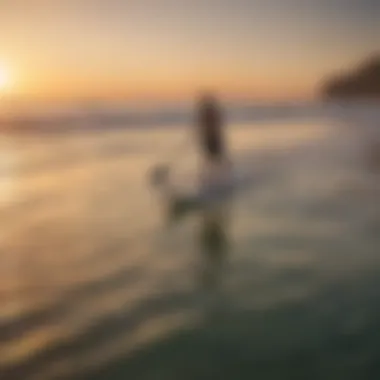
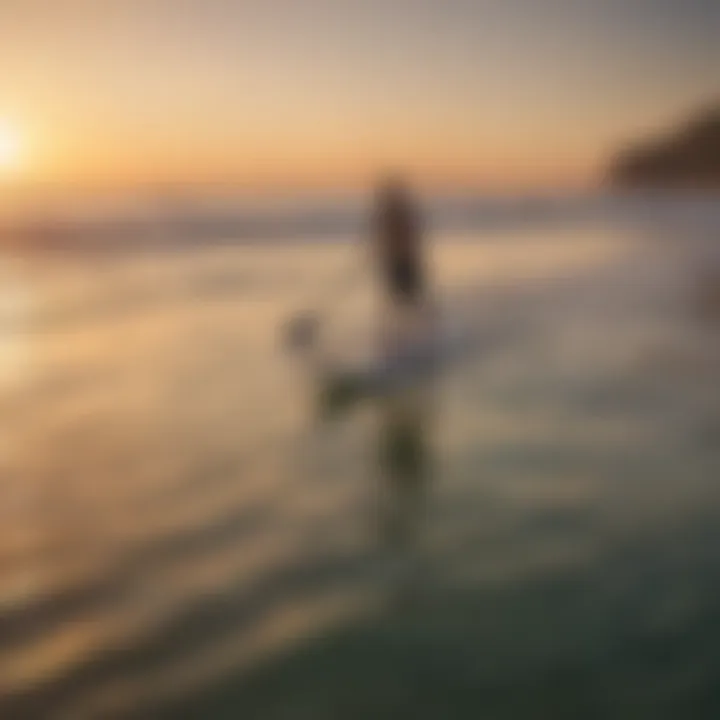
Intro
Paddle surfing, often viewed as a leisurely pursuit, hides layers of complexity beneath its surface. This engaging sport springs from the rich cultural tapestries of coastal communities worldwide, evolving from traditional surfing practices. As anyone who's tried it can tell you, paddle surfing marries athleticism and serenity, offering a unique interaction with water landscapes like no other. The rhythmic, meditative strokes of the paddle provide not just a means to navigate, but also a way to connect deeply with nature.
As you embark on this journey into the world of paddle surfing, expect to dive into its origins, discover essential gear, and develop necessary skills. You will meet seasoned paddle surfers and curious newcomers alike, all united by their passion for this water sport. Whether you're looking to get your feet wet for the first time or refine your techniques, there's something here for everyone. Get ready to unravel the many layers of paddle surfing!
Gear Essentials
Paddle surfing might appear simple at first glance, but the right gear can greatly enhance your experience. Understanding the essential pieces of equipment will not only ensure your safety but also make your time on the water much more enjoyable. In this section, we will break down the must-have gear along with some useful pointers on how to keep everything in tip-top shape.
Top Picks for Watersports Equipment
- Stand-Up Paddleboard (SUP): The heart of paddle surfing. Choose a size appropriate for your skill level and weight. Inflatable boards are portable and easy to store, while rigid boards offer better performance.
- Paddle: A good paddle is lightweight with an adjustable length. Look for materials like carbon fiber for racing or aluminum for a budget-friendly option.
- Personal Flotation Device (PFD): Safety first. A properly fitted PFD ensures you stay afloat and is often required, especially in certain waterways.
- Leash: This keeps your board attached to you. In case of a tumble, it prevents the board from drifting away.
- Wetsuit or Rash Guard: Depending on the water temperature, either of these offers thermal protection and shields against sun exposure.
While browsing for this gear, it might be tempting to go for the cheapest option, but investing in quality equipment pays off in durability and performance.
Maintenance and Care Tips for Gear
Caring for your paddle surfing gear is crucial for prolonging its life and ensuring safety. Here are some simple yet effective maintenance tips:
- Rinse with Freshwater: After each session, rinse your board and paddle with fresh water to remove salt and sand that can degrade the materials.
- Store Properly: Keep your gear out of direct sunlight and extreme temperatures. Boards should ideally be stored flat or upright.
- Inspect Regularly: Check your board for dings or scratches. Small repairs done promptly can save you from costly replacements down the line.
Adopting these practices will ensure you enjoy countless days on the water while keeping your gear in great shape.
"Maintaining your paddleboard is like nurturing a good relationship; the more you care for it, the better it performs."
Techniques and Tips
The techniques in paddle surfing range from the basics of balance and paddling to advanced maneuvers that showcase your skills. Embracing these techniques will enhance your surfing experience and help you navigate diverse conditions with confidence.
Beginner Tips for Each Watersport
- Find Your Stance: Keep your feet shoulder-width apart. A low center of gravity helps maintain balance.
- Paddle Correctly: Use your core to power your strokes instead of just your arms. Engage your whole body for better efficiency.
- Look Ahead: Always gaze at the horizon rather than down at the water. This helps with balance and awareness.
Advanced Techniques for Skill Enhancement
- Edging: Learning to edge your board will dramatically improve your speed and control through waves.
- Turning Techniques: Master pivot turns and sweep strokes to change direction smoothly.
- Utilizing Wind and Currents: Understanding how to use environmental factors can enhance your paddling, allowing for a more engaging experience.
As you progress in your paddle surfing journey, these techniques will not only build your confidence but also deepen your appreciation for the sport.
Preamble to Paddle Surfing
Paddle surfing isn’t just another water sport; it’s a dance between the paddler, the board, and the waves. In the realm of aquatic experiences, it holds a special place that intertwines fitness, skill, and the sheer joy of navigating across shimmering waters. This section serves as a compass, guiding readers through the foundational elements of paddle surfing, recognized for its calming yet invigorating nature.
Definition of Paddle Surfing
Paddle surfing, often referred to as stand-up paddleboarding (SUP), boils down to a simple yet engaging activity. Basically, you stand on a broad, stable board and propel yourself forward using a long paddle. The beauty of paddle surfing lies in its accessibility; whether you are lounging on serene lakes or braving the surf at the coastline, it welcomes all skill levels.
In essence, paddle surfing combines the art of balance and movement. This activity not only enhances strength and coordination but encourages a deeper connection with nature. For many, it's about more than just sport; it’s about experiencing peace and finding that perfect moment amidst the rush of life.
The Evolution of the Sport
Paddle surfing has a history that stretches back quite a ways. It traces its roots to ancient Polynesian and Hawaiian cultures, where it was used for fishing and transportation. Back in the day, locals utilized similar techniques to navigate the waters, transforming both work and leisure into a seamless endeavor. The visual image of traditional Polynesian men standing on their wooden boards, paddling through azure waters, gives a glimpse into the sport's rich heritage.
Fast forward to the modern landscape, paddle surfing has evolved exponentially since the early 2000s. It began catching on globally as adventurers and outdoor lovers started recognizing its multi-faceted appeal. Weekend warriors, surfers on rest days, and fitness enthusiasts began adopting the sport. Social media played a dramatic role in this rise, with splendid photos of people paddling against picturesque backdrops flooding platforms.
Not to mention, the advent of inflatable paddleboards has further contributed to its popularity, making the sport more accessible than ever before. Easy to transport and store, these boards have opened doors for casual users who once found the rigidity of traditional paddleboards off-putting. As you stand on your board, gliding through reflections of sky and water, it feels like you’re riding on a piece of history, connecting past with present.
"Paddle surfing isn't just about the ride; it’s a soulful journey on the water, melding physical exertion with mindfulness and appreciation of the natural world."
In short, paddle surfing has grown from a necessity to a globally sought-after pastime. Today, it attracts surfers, paddleboarders, instructors, and everyone in between, each finding their unique rhythm and reason on the water.
Origins and History
Understanding the origins and history of paddle surfing provides valuable context for both newcomers and seasoned enthusiasts. This segment highlights the cultural significance and evolution of the sport, showcasing how past practices shaped the modern paddle surfing experience. Learning about its roots not only deepens appreciation but also emphasizes the importance of respecting traditions while advancing contemporary techniques.
Cultural Roots in Polynesia
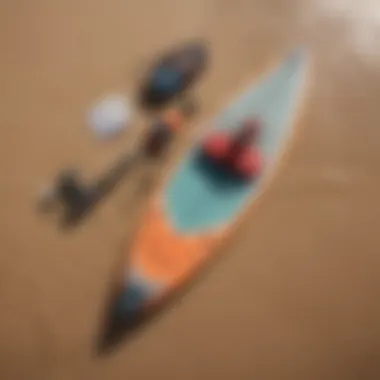
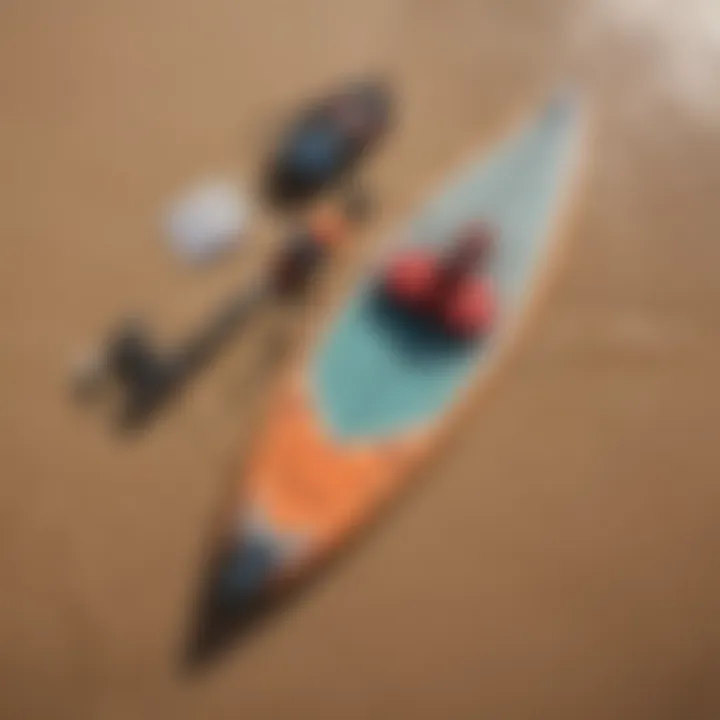
Paddle surfing traces its lineage back to Polynesian cultures, where longboards and paddles were common tools for fishing, transportation, and recreation. This ancient sport was a way of life, linking communities with their environment. The Polynesian Islanders utilized long, sturdy canoes called va'a, which they maneuvered using simple paddles.
These islanders displayed their remarkable balance and agility, standing on their canoes to cast nets or fish. Such practices formed the groundwork for what we now recognize as paddle surfing today.
One can't help but admire how deeply intertwined paddle surfing is with Polynesian tradition, embodying a connection to the ocean that runs far deeper than mere sport. Alongside physical prowess, it emphasizes community bonds and respect for nature. This ethos is still palpable among today’s paddlers, who often speak about the meditative quality of being on the water, reflecting a deep-rooted appreciation that transcends mere activity.
"Stand-up paddle surfing invites the soul to become one with the sea, much like our ancestors did on their va'a."
— An expert paddle surfer reflecting on the cultural significance.
Growth in Popularity Globally
Though paddle surfing has ancient roots, its recent surge in global popularity can be attributed to various factors. In the 20th century, a few trailblazing surfers from Hawaii began standing on large surfboards with paddles to navigate the waves. What initially started as a practical method to teach surfing to beginners evolved into a full-fledged sport, gaining traction worldwide.
Several key developments have contributed to paddle surfing's growth:
- Accessibility: Modern technology has made paddleboards lighter and more user-friendly. This accessibility allows people of different ages and skill levels to embrace the sport.
- Global Awareness: Increased exposure through social media and surf films has showcased paddle surfing as an exhilarating and serene way to explore coastal areas.
- Community: Paddle surfing promotes a culture of camaraderie among practitioners, creating a community that shares experiences rather than just competition.
- Health Benefits: Paddle surfing is recognized for its physical health advantages, including improved cardiovascular fitness and core strength, attracting fitness enthusiasts.
In recent years, paddle surfing has transformed into a global phenomenon. From tranquil lake paddles to challenging ocean waves, enthusiasts continue to carve their paths on water, all while honoring countless generations that came before them.
Techniques and Skills
Understanding the techniques and skills integral to paddle surfing is crucial for anyone wanting to take to the water with confidence. These elements not only enhance performance but also ensure safety and enjoyment during the sport. Mastering the basics like paddle strokes, maintaining balance, and proper maneuvering can dramatically improve one’s capability on a paddle board. Moreover, developing these skills sets a solid foundation for tackling more complicated maneuvers as one becomes more advanced.
Fundamental Paddle Techniques
At its core, effective paddle surfing relies heavily on mastering fundamental paddle techniques. These include the forward stroke, backward stroke, and the sweep stroke. The forward stroke is the primary means of moving forward; using your core and arms efficiently will enable greater speed without exhausting oneself.
- Forward Stroke: Picture yourself drawing the paddle through the water. Keep your top hand above your eyes, and push down with your bottom hand. A smooth, rhythmic motion allows for better propulsion.
- Backward Stroke: This stroke slows you down or helps you steer backward. Use the same technique as the forward stroke but in reverse.
- Sweep Stroke: Ideal for turning, this motion involves angled sweeps to the side of the board while relying on your core to pivot.
By consistently practicing these strokes, surfers can develop fluidity and strength, making their experiences on the water more enjoyable.
Balance and Stability
Paddle surfing demands a level of balance and stability that separates the pros from novice surfers. A stable paddle board is vital for maintaining equilibrium, particularly when the water gets choppy.
Some tips to enhance balance include:
- Foot Placement: Feet should be my shoulder-width apart, with knees slightly bent. This stance lowers the center of gravity.
- Core Engagement: Keeping the core tight aids in maintaining posture, especially during waves.
- Gazing Ahead: Focusing on the horizon rather than the board or water helps maintain steadiness.
Strong balance and stability reduce the likelihood of falls, making it easier to concentrate on the surrounding experience and enjoy the ride.
Turning and Maneuvering
Turning and maneuvering the paddleboard effectively can significantly enhance your overall paddle surfing experience. Quick direction changes are often necessary, especially in crowded or dynamic environments.
- Basic Turning: The easiest way is to apply a sweep stroke on one side while keeping your weight centered. This will naturally pivot the board in the opposite direction.
- Cross-Step Turning: For more advanced surfers, the cross-step technique allows for sharp turns by stepping toward the tail of the board and applying weight.
Knowing how to turn efficiently not only boosts skills but also increases enjoyment, allowing surfers to respond to changing water and wind conditions with agility.
Advanced Techniques for Experienced Surfers
As paddle surfers become more skilled, they often seek to elevate their abilities through advanced techniques. Here are some notable methods to explore:
- Downwind Surfing: This technique takes advantage of wind-assisted rides, where surfers position themselves to feel the wind at their backs, leading to faster rides.
- Surfing Waves: For those looking to catch some action, learning to surf waves on a paddleboard can be both thrilling and challenging.
- Yoga on the Water: Combining paddle surfing with yoga creates balance and versatility, allowing surfers to practice skills while enjoying the tranquility of the water.
Practicing these advanced techniques will not only enhance overall skill but also enrich the experience, making paddle surfing a sport that's never truly mastered—there's always something new to learn.
Essential Gear for Paddle Surfing
When it comes to paddle surfing, having the right gear isn’t just a nice-to-have; it’s a vital part of the sport. The right equipment can vastly improve your experience on the water, whether you are a newbie still finding your feet or a seasoned pro looking to push your limits. Good paddle gear will ensure you're safe, comfortable, and able to perform to your best.
Choosing the Right Paddleboard
Picking the right paddleboard is akin to choosing the right bicycle for a long-distance tour; it sets the tone for the entire journey. Paddleboards come in various shapes and sizes, each catering to different styles and skills. Generally, they fall into three main categories: all-around, touring, and racing boards.
- All-Around Boards: Perfect for beginners, these boards are wider and thicker, offering stability for those still mastering balance.
- Touring Boards: These are longer and narrower, designed for distance and efficiency. Ideal for those who wish to explore vast stretches of water.
- Racing Boards: Tailored for speed, they are slimmer and more aerodynamic, suited for experienced surfers.
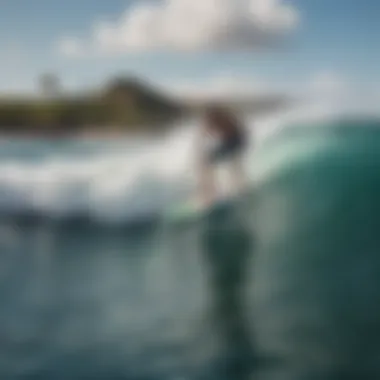
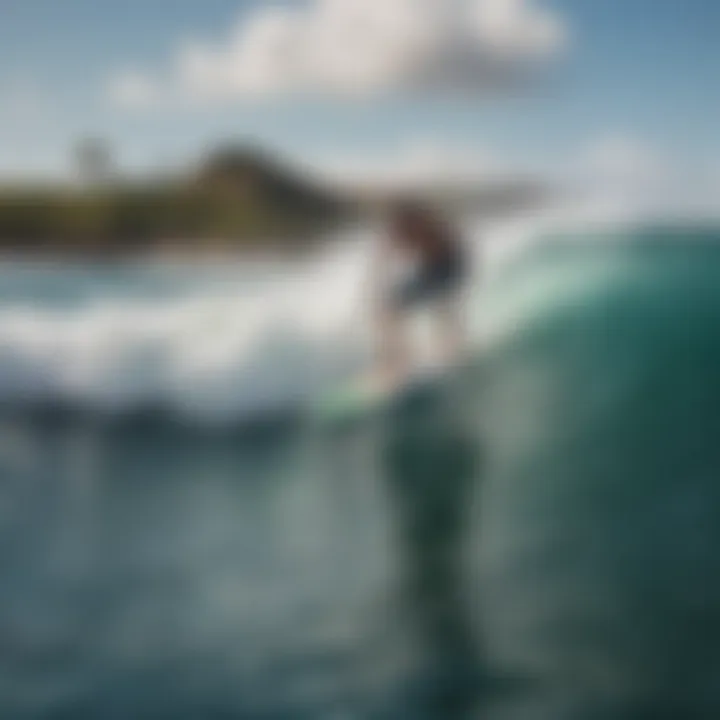
Other factors to consider include the material, weight capacity, and fin setup. A good board should feel like an extension of your body on the water—if it doesn’t, it’s time to shop around a bit more.
"The right paddleboard can make you feel like you’re gliding on air, while the wrong one may leave you floundering like a fish out of water."
Paddles: Material and Design Considerations
The paddle is your primary tool for navigation, so understanding its design is crucial. Generally, paddles come in three material types: plastic, fiberglass, and carbon fiber. Each has its pros and cons.
- Plastic Paddles: Affordable and durable, they are a great choice for beginners who might not want to invest heavily right away. However, they are heavier and less efficient in the water.
- Fiberglass Paddles: These offer a good balance between weight and durability. They allow for longer sessions without tiring your arms too much.
- Carbon Fiber Paddles: Ultra-lightweight and exceedingly strong, these paddles are favored by competitive paddlers. The price tag is heftier, but the performance gains are substantial.
The design also plays a significant role. Blade shape, width, and length all affect how the paddle interacts with the water. A wider blade is better for power, while a more narrow one enhances speed. Finding the right paddle can dramatically change how you maneuver through the water.
Personal Safety Equipment
Safety can never be overemphasized, and in paddle surfing, investing in a personal flotation device (PFD) is non-negotiable. Aside from a PFD, several other safety items should become standard in your kit:
- Leash: This keeps you tethered to your board, preventing it from drifting away should you fall.
- Whistle: A simple yet effective tool for signaling for help or locating fellow surfers.
- Sunscreen: Don’t underestimate the power of the sun. A high SPF sunscreen helps protect your skin from harmful rays.
- First Aid Kit: Always good to have on hand, especially if you’re exploring less frequented waters.
Putting safety first not only protects you but also enhances your enjoyment. The more you know you’re covered, the more you can focus on mastering your paddle skills.
Safety Practices in Paddle Surfing
Engaging in paddle surfing, while exhilarating, comes with its share of risks and unpredictable elements. Therefore, understanding the importance of safety practices is paramount for enjoying this water sport without jeopardizing oneself or others. By implementing effective safety measures, paddle surfers enhance not only their safety but also the overall experience of the sport. The following sections provide an in-depth look at vital safety practices that every paddle surfer should embrace.
Pre-Session Preparations
Before even stepping onto the water, pre-session preparations can make a world of difference. These preparations involve a series of essential steps that help ensure a smooth, safe outing. Here’s what to keep in mind:
- Check Equipment: Always ensure that your paddleboard, paddle, and any safety gear like a life jacket are in good condition. Look for cracks, wear, or tears that could lead to unexpected mishaps.
- Familiarize with Your Area: Have a good grasp of the water route you plan to tackle. Knowing where sandy spots, rocky areas, or potential hazards lie is crucial for a safe session.
- Plan Your Timing: It’s wise to paddle during daylight and in periods when water conditions are calmer. Early mornings or late afternoons often provide calmer weather and less crowded waters.
By conducting thorough pre-session checks, paddle surfers minimize their risks effectively.
Understanding Weather and Water Conditions
The essence of safe paddle surfing lies in respecting the power of weather and water conditions. Some key factors to assess include:
- Wind: Strong winds can make paddling challenging, especially for beginners. Always check wind forecasts before heading out.
- Tides and Currents: Understanding local tides is vital. Currents can be deceptive and may easily sweep an unprepared surfer away, so knowing them beforehand can save a lot of trouble.
- Temperature: Cold water can lead to hypothermia, even in mild conditions. Dress appropriately, and consider a wetsuit if necessary.
It’s essential to stay up-to-date with weather apps or reliable sources like Wikipedia to monitor the above factors before setting out.
Emergency Procedures
Even with the best preparation, emergencies can still happen. Thus, knowing your emergency procedures can be lifesaving. Below is a guide to essential protocols:
- Stay Calm: In case of an emergency, taking a moment to breathe and think can make a significant difference.
- Signal for Help: Use whistles or bright-colored gear to signal for assistance. A clear signal can help others identify you in distress quickly.
- Know What to Do If You Fall Off: If you end up in the water, remember to float on your back and breathe until you regain your bearings. Try to get back on your paddleboard as soon as possible.
Important Note: Regularly review and practice these emergency procedures. Knowing them inside out can prevent a disaster from spiraling out of control.
By incorporating these safety practices into your paddle surfing routine, you not only elevate your level of preparedness but also foster a culture of care and responsibility within the community. Paddle surfing can be immensely rewarding, but it’s vital to approach it with respect for both nature and personal safety.
Environmental Considerations
The relationship between paddle surfing and the environment is a critical aspect of participating in this thrilling activity. Understanding how paddle surfing impacts marine ecosystems is essential not just for the sport's enthusiasts, but also for the broader community that cherishes our natural habitats. Paddle surfers often find themselves in close proximity to delicate marine life, which can lead to disturbances if appropriate care is not taken. The environment where paddle surfing occurs is as much a part of the experience as the technique and thrill of riding the waves.
This section aims to elucidate various environmental aspects, coupled with strategies for paddlers to minimize their impact, ensuring that the waters we cherish remain pristine for generations to come.
Impact on Marine Life
Paddle surfing can create ripples—both literally and figuratively—through the ecosystems found in coastal areas. As boards glide through the waters, the drops in water quality and alterations in natural habitats can become problematic. For instance, marine organisms such as seals, dolphins, and various fish species may be affected by noise, physical interference, and pollution.
Key areas of concern include:
- Habitat disruption: Paddlers might unintentionally invade breeding grounds or resting areas for marine wildlife. Avoiding these zones can be crucial in protecting species.
- Plastic pollution: The use of plastic paddles or inappropriate disposal of gear contributes to ocean pollution. Switching to eco-friendly options can alleviate this issue.
- Chemical run-off: Surfers often come into contact with water that might have been influenced by local runoff. Knowing potential hazards before hitting the water is important.
"Those who are able to respect the ocean and its inhabitants will develop a richer bond with the surfing experience itself."
Sustainable Practices for Paddle Surfers
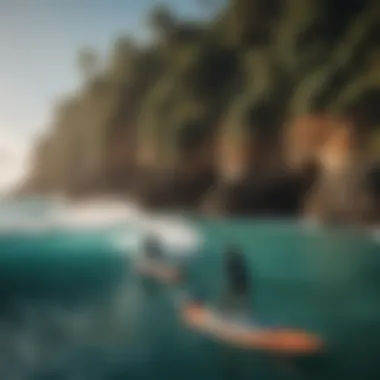
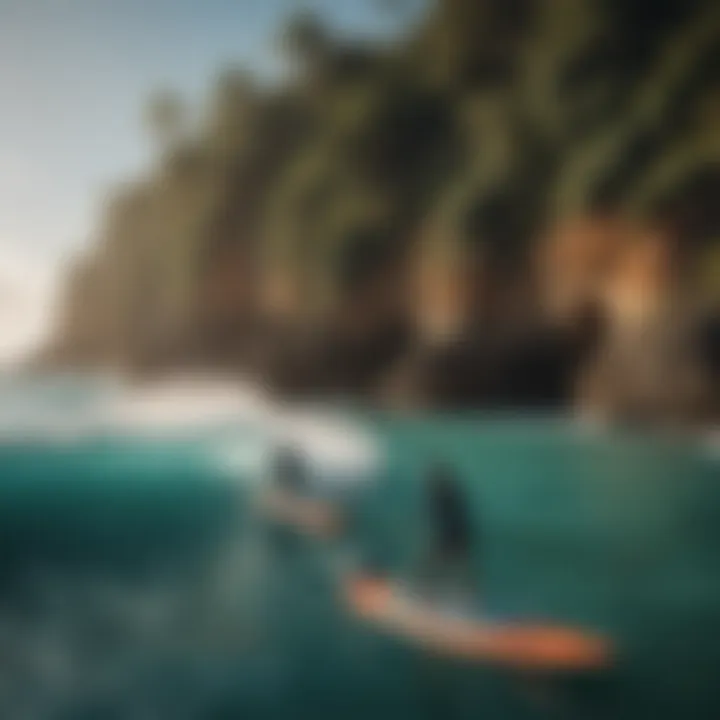
Embracing sustainability as a paddle surfer entails committing to practices that protect and preserve our oceans. Here are some responsible habits to adopt while hitting the waves:
- Choose eco-friendly gear: Opt for paddleboards and paddles made from sustainable materials. There are several brands prioritizing environmentally friendly manufacturing processes.
- Avoid crowded and sensitive areas: When selecting your paddling destination, steer clear of regions that are known to be breeding grounds for marine life. Choosing less crowded spots not only benefits the local fauna but also enhances your paddling experience.
- Leave No Trace: Simple but effective, the “Leave No Trace” principle encourages paddlers to take any trash with them and upkeep the beauty of our natural spaces. Participating in beach clean-up events can also foster community and responsibility.
- Educate yourself: Familiarizing yourself with local ecosystems and understanding the species you may encounter can promote responsible interactions with marine life.
By weaving sustainable practices into the fabric of paddle surfing, enthusiasts can enjoy their passion while simultaneously safeguarding the environments they cherish. This synergy not only helps ensure that the beauty of the ocean remains intact, but it also creates a fulfilling and respectful bond between paddle surfers and nature.
Popular Paddle Surfing Locations
Paddle surfing, with its blend of tranquility and adventure, begs for exploration in the right spots. The locations where this sport unfolds not only shape the experience for the surfer but also cater to skill levels and personal preferences. Engaging in paddle surfing in top locations can enhance skills, connect individuals within the community, and provide unforgettable memories in nature. Thus, knowing these spots is key for anyone serious about the sport.
Top Destinations for Beginners
When stepping into the world of paddle surfing, beginners need welcoming waters and manageable conditions. Starting at user-friendly locations can build confidence and facilitate learning.
- Lake Tahoe, California/Nevada: Known for its calm waters and breathtaking scenery, Lake Tahoe is ideal for novices. The clear blue waters are effortlessly inviting, and there's a range of rental shops that offer beginner lessons.
- The Florida Keys: Offering a warm climate and gentle waves, the Keys are another fantastic starting point. The shallow waters allow for safe practice, and the backdrop of palm trees creates a truly picturesque environment.
- Hanauma Bay, Hawaii: This natural preserve not only provides a safe spot for beginners but also showcases vibrant marine life. It's the perfect place for newbies to paddle while enjoying the beauty of underwater ecosystems without overwhelming waves.
Challenging Spots for the Advanced Surfer
For seasoned paddlers, the thrill of tackling difficult waves and currents often provides the most satisfaction. Here are a few notable locations for those who have honed their skills.
- Brooklyn Bridge Park, New York: Urban sensations blended with strong currents make this a challenging yet exhilarating location. Experienced surfers can navigate through lively waterways while enjoying the iconic skyline.
- Nazaré, Portugal: Famous for its gigantic waves, Nazaré is only for the bravest. It attracts advanced surfers eager to test their mettle against powerful swells that can reach heights unmatched by many locations on Earth.
- Malibu, California: Often regarded as a mecca for surfers, Malibu offers areas with fierce waves and exhilarating breaks. Proficient surfers can enjoy both competition and camaraderie, as many advanced paddle surfers flock to this legendary strip of coastline.
Hidden Gems Around the World
Not every remarkable site is a household name. Some off-the-beaten-path locations offer unique paddle surfing opportunities with serene surroundings and stunning landscapes.
- Lago di Braies, Italy: Nestled in the Dolomites, this beautiful lake boasts crystal-clear waters surrounded by spectacular mountains. It's perfect for a peaceful paddle, away from the hustle and bustle.
- Yasawa Islands, Fiji: Known for their natural beauty, these remote islands offer tranquil waters and unspoiled beaches. They present a chance to paddle in privacy, creating a magical escape from crowded tourist spots.
- Saba Rock, British Virgin Islands: Often overlooked, Saba Rock gives adventurers access to pristine aquatic environments, complete with spectacular coral reefs and playful turtles. This place is perfect for those who desire both exploration and serenity.
"Choosing the right location is essential for a fulfilling paddle surfing experience, blending the thrill of the sport with the beauty of nature."
These destinations encompass a diversity of landscapes and challenge levels, ensuring there's a suitable spot for every type of paddle surfer. Understanding the nuances of each helps forge connections within the paddle surfing community and enhances one’s skills in this dynamic sport.
Community and Culture
Paddle surfing is more than just a sport; it's woven into a vibrant community and culture that nurtures a sense of belonging among enthusiasts. The camaraderie found in paddle surfing circles offers emotional and social benefits that can be just as rewarding as the sport itself. Engaging in paddle surfing can help create lasting friendships and connections that span the globe, fostering both local and international relationships.
The Social Aspect of Paddle Surfing
When you peel back the layers, the social aspect of paddle surfing shines through. It’s not just about gliding across the water with a paddle in hand. Local meetups turn into social events where paddlers gather to share tips, tricks, and tales of their adventures. Whether it’s joining a group for a sunset paddle or participating in a charity race, these moments nurture community bonds.
- Shared Experiences: Mateship is at the heart of paddle surfing. One can often find friends encouraging newcomers or veterans supporting each other in chasing waves.
- Inclusivity: Paddle surfing tends to attract a diverse crowd, building a welcoming atmosphere that demystifies the sport for beginners. There’s always room for newcomers, and many seasoned surfers take the time to share their knowledge.
- Shared Knowledge: Online forums such as Reddit have become places for the paddle surfing community to interact, where questions are answered, and advice is freely shared. You will find threads dedicated to everything from gear recommendations to technique discussions.
Sharing stories is a rite of passage in this community, one that enhances both skills and friendships. Mutually supporting each other, during and after sessions, wraps the participants up in a warm social fabric rarely experienced in more solitary sports.
Events and Competitions
Events and competitions in paddle surfing serve as a linchpin, binding the community together while also pushing the boundaries of the sport. These gatherings showcase talent and foster a spirit of friendly competition, allowing participants to challenge themselves and witness the evolution of techniques.
- Local Competitions: Many coastal towns host amateur events, providing an easy entry point for novices to test their skills. These competitions bring the local community together and encourage rising talent.
- Festivals and Expos: Paddle surfing festivals, complete with demos and workshops, allow enthusiasts to learn from experienced paddlers, mingle with vendors, and test out new gear. These events often feature panels discussing the latest techniques, environmental issues, and the progression of paddle surfing as an inclusive sport.
- International Events: On a larger scale, international competitions attract paddlers from around the world, turning beaches into vibrant stages for showcasing skill and camaraderie. Events such as the Paddleboard Race Series draw in not just competitors but thousands of spectators, sharing in the excitement and celebrating the sport.
"The paddle surfing community reflects deep respect for nature and each other, making it a truly unique environment for growth and enjoyment."
In essence, community and culture within paddle surfing offer a sanctuary for individuals of varying backgrounds. It holds true that while the waves may ebb and flow, the connections forged through shared passion remain steadfast.
The End
Leaving the world of paddle surfing dictates the necessity of looking back and reflecting on the sport's diverse aspects. Paddle surfing is more than just a recreational activity; it fosters a genuine connection with nature, strengthens community ties, and promotes mental and physical well-being. When considering the importance of paddle surfing, one must recognize its broad appeal across different demographics, ages, and skill levels.
Summarizing the Appeal of Paddle Surfing
The allure of paddle surfing is hard to overstate. It serves as a gateway to experiencing waterways in a manner that few other activities can match. The sensation of gliding smoothly over the water, while engaging both body and mind, encapsulates what makes this sport so appealing. Paddle surfing is accessible to everyone, from seasoned pros carving waves to beginners paddling along calm shores. The blend of exercise and tranquility is a magnet for individuals seeking both fitness and an escape from the hustle of daily life.
Paddle surfing also enriches social connections; many form clubs or groups that paddle together regularly. Sharing stories of their experiences while sipping on coconut water fosters friendships that last well beyond the shoreline. Additionally, paddlers often encounter nature in its raw form, whether it's spotting dolphins leaping beside them or taking in stunning sunsets cast over water. This combination of physical benefits and social bonding truly crafts a holistic experience that few recreational activities can offer.
Encouragement for Exploration
As one closes this discussion on paddle surfing, the encouragement to explore is undeniable. There’s a world of opportunities waiting just beyond the horizon. Each new location offers something different, whether it's the surf breaks of Hawaii or the calm lakes of the Midwest. With paddle surfing, one is always learning. Trying out new techniques or simply navigating unfamiliar waters can be a thrilling adventure. Remember, every journey begins with a single stroke of the paddle.
In seeking out new locations or honing skills, a paddler secures a sense of fulfillment that stretches beyond the context of sport. The commitment to learn and adapt, combined with a healthy respect for the environment and fellow water enthusiasts, reinforces a positive community. Whether you are an absolute novice or an experienced surfer, there’s always room for growth and exploration.
"Every wave tells a story and every sunset inspires a new adventure."
So gear up, hit the water, and don’t just settle for a paddle – embrace the culture, immerse yourself in the community, and discover the ever-evolving art of paddle surfing.



